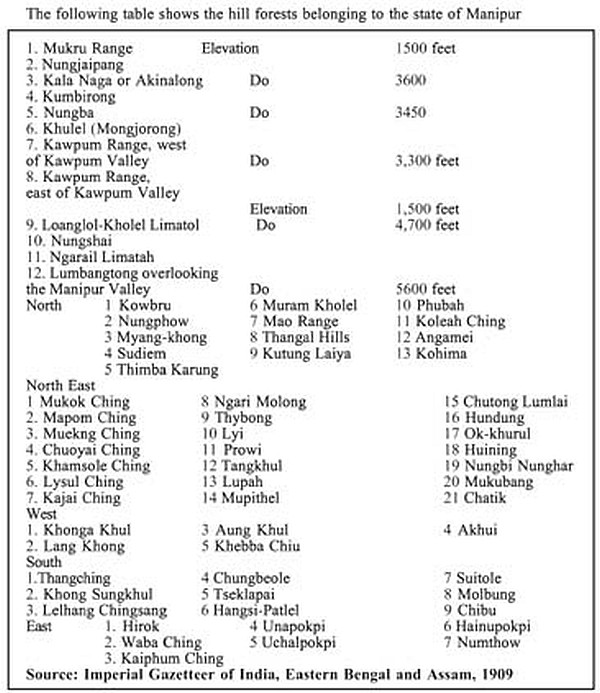Forests of Manipur during Pre-British Period (1826-1891)
- Part 4 -
Akham Bonbirdhwaja Singh *

There is a mention in the Royal Chronicles that there were reports of encroachments (The Cheitharol Kumbaba Pp 310-311). However, on checking up it was found that there was one hut and a few trees were felled. Some cultivation of kitchen items was found. But no human settlements were found. There are also reports that the King used to go for prayers regularly to the Koubru Hills.
The most important act of consolidation could be cited as the exchange of Surma Valley with the Jiri Borak Drainage Forests known as Kalanaga Hills in 1833 under a treaty signed between the king and British. That was quite a huge chunk of forest land and sparsely populated.
Wild life
Quite a good number of animals have been accounted in the writings of the earlier Political Agents and renowned authors on Manipur. The principal wild animals noted in the valley at all seasons, were the tiger, wild-hog, hog-deer, and a large species of deer peculiar to the country, which frequents the swamps in the South. The large species of deer described to be frequenting swamps in the south could have been Sangai and large swamp deer the associates of Loktak.
It had been described that the tiger and wild-hog are at times very destructive to human life. The techniques of hunting tigers by preparing hunting parties and making stockades when they have become man eaters have been described in detail. In fact, tiger hunting has been cited as popular sports. There are also accounts of Sajal (Cervus unicolor), sangai (Rucervus eldi eldi), Saji (Muntiacus muntjak), Swamp Deer (Cervus duvaucelli), Wolf (Canis lupas pallipes), Leopards (Panthera pardus), Wild Boars (Sus scrofa) being caught. There are no records of having jackals in the country.
In addition to the above mentions about the encounters recorded in the Royal Chronicles and other documents, the various accounts and reports also mentioned the following animals and birds.
Animals: Elephants (Elephas maximus), tigers (Panthera tigris), leopards (Panthera pardus), bears (Selenarctos thibetanus), rhinos (Rhinoceros unicornis), bison (Bos gaurus), serow (Capricornis sumatraensis). Hoolock (Hylobates hoolock), Slow loris (Nycticebus coucang), Otter (Lutra perspicillata), Porcupine (Hystrix indica), Rhesus macaque (Macaca mulatta), bats and flying foxes, Flying lemurs etc. Bisons are doubtful. Mithuns ( Bos frontalis) could have been mistaken for bisons.
Birds: Humes pheasant (Syrmaticus humiae humiae), jungle fowl (Gallus ferrugineus under Fam: Phasianidae), Kaliz (Lophus leucomelana), snipe (under Fam Scolopacinae), partridge (Bambusicola fytchii), ducks (under Fam: Anatidae), geese (under Fam: Anatidae), owls hawks, parrots etc..
There are accounts of snakes such as Pythons, Large snakes, Vipers etc.
Forest Fires : Forest fires have been common. It has been described as usual annual fire. The forest in and around the central plains have been described as of poor growth and not so lush and it must be due to the recurring fire every year. Burning for Jhum was also common. A good burn was believed to produce a good crop and due preparations were taken to get a good burn. The incident of fire crossing the jhum limit was avoided, but not uncommon.
Hunting : Hunting with guns might have been confined with the Europeans and members of royalty. The locals might have been using still the method of trapping, bows and arrows and spears. The best time for shooting have been described as the period after the firing of the jungle, the young shoots begin again to sprout. Then early in the morning and towards the evening, the deer may be seen nipping the young shoots, and if the deer be in plenty, a tiger will most probably be awaiting them at no great distance.
Elephant hunting was one of the annual feature and for elephant Shikar, the King used to go to forests. Koubru forests, Shugnu Forests, Laimaton Forests etc. were among the common elephant capturing places where elephants were captured by digging shikar trenches (Shong in archaic Manipuri) and constructing stockades (the description of the arrangements are like that of Khedda Shikar done by Mysore Rajas). Every year, a number of elephants were caught for royal uses. There are also records of hunting of tigers which are quite common, but the records of hunting of leopards are rare.
The common wild duck found in the valley throughout the year. Partridges, quail and snipe are abundant; and immense flights of wild geese, and teal of many varieties, diversify for a time annually the Sportsman's amusements.
Minerals : Captain Pemberton made mentions of the salt wells on the foothills on the eastern side. The best are of those in Waikhong, Chandrakhong, Ningel and Sekmai. Sometimes it fetched unusually high revenue. This was sufficient for the people in central valley and used as item for bartering with other items with hill people. Occurrence of Minerals such as limestone, hornblende, and iron ore has been recorded, but there has not been any mention of commercial extraction.
Occurrence of copper is also reported in Yangoupokpi, but not extracted. But there are uses of Iron ore for producing swords as in those days, swords and spears were made locally.
The principal items are Axe, Hoes, Plough shares, for felling trees, preparing grounds etc. Mentions have been made of two stage iron smelting, first for purification of the ores, and second for wood based smelting.
The country was reported to produce very fine quality building stones.
To be continued...
* Akham Bonbirdhwaja Singh wrote this article for The Sangai Express
This article was posted on September 10, 2013.
* Comments posted by users in this discussion thread and other parts of this site are opinions of the individuals posting them (whose user ID is displayed alongside) and not the views of e-pao.net. We strongly recommend that users exercise responsibility, sensitivity and caution over language while writing your opinions which will be seen and read by other users. Please read a complete Guideline on using comments on this website.







